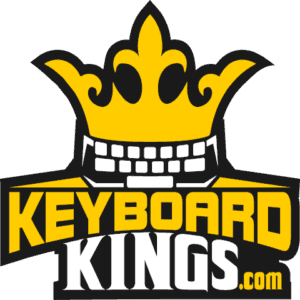The modern high-quality, tactile, responsive mechanical switch along with silent and smooth membrane and many other types of keyboards that you, as the avid keyboard enthusiast are using, have gone through an immense number of evolutions to reach the state of comfort and accessibility that they have now.
That might make you wonder, what was the history of the modern keyboard like, and what does the future hold for the computer keyboard? Well, that’s exactly what I’m here to tell you.
In this article, I’m going to talk about where the journey of the modern QWERTY keyboard started from, the different keyboards and key switches that came in between the ages to the masterpieces that you and I are using right now.
I’m also going to talk about the future of keyboards so, if you want to know everything about the modern computer keyboard, sit back, relax and read this article till the end.
Table of Contents
The Historic Invention of the QWERTY layout Typewriter – 1870s
You might not believe it, but the story of the modern computer keyboard starts off at a rather unfamiliar point in time. The invention of the QWERTY typewriter. Inventor Christopher Latham Sholes introduced the modern Typewriter with a specific layout to the world in 1874 which was basically meant to type characters assigned to keys of a mechanical writer.
The QWERTY layout of this machine can now be seen in almost all types of keyboards. This may seem silly now, but the reasoning behind the formation of the QWERTY layout was that Christopher wanted to place letter keys that were commonly typed together, far away from each so the mechanical hands of the writer wouldn’t collide and cause a jam in the machine.
It’s so fascinating that such a specific use case would lead to the invention and usage of the QWERTY keyboard which comes in many different shapes and sizes in today’s world.
This typewriter was critically acclaimed by inventors and general users in the 19th century and went on to be used in offices and households for decades upon decades to come.
This however was just the beginning of the era of the keyboard. Many layouts, switches, boards, and designs have since made their way to the market and many have left as well. Let’s take a look at all of the different versions and evolutions that led to the creation and widespread of the modern keyboard.
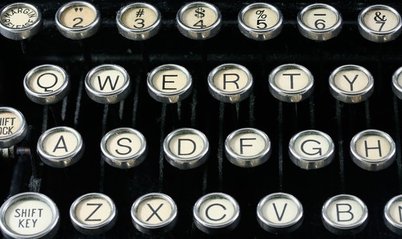
The Use of Keyboard in Computer Terminals – the 1960s
The same QWERTY layout of the modern layout typewriter was then implemented into the high-end servers and mainframe computer systems in the 1940s. In this era, the layout became so popular that it was also being utilized in teleprinting machines.
Fast forward a couple of decades, and you’ll find the next physically closest thing to a computer in the form of a video or computer terminal. These machines were invented in the 1960s and were utilized mainly for the input and transcription of data.
The layout was kept the same as the modern typewriter however, the process of clicking and taking input was converted from mechanical form completely, to reed switches which worked with the help of an applied magnetic field. When I say they resembled computers physically, I mean ONLY physically. Because of a monitor and keyboard being integrated together to form the machine, the terminal looked much similar to the modern computer.
Video terminals were also called dumb terminals. The reason for this was the incapability of these machines to process any information on their own. They required processing power from larger computers and servers. The switch from teleprinters to a much simpler QWERTY keyboard in the computer terminals was subtle but very important for the development and further evolution of the modern computer keyboard.
This machine and the method of using the QWERTY keyboard for character and key input paved the way for what you know and use as basic computer keyboards.

Ergonomic Layout Keyboards – 1970s
Now the keyboard was widely known. In the 70s, tech companies around the world knew QWERTY keyboards to be the most popular and useful device for data input. Innovations and creativity were slowly grabbing hold of the keyboards.
Keyboards in this time weren’t as you see them today – slim and compact. They were beefy. They were like large boxes with keys on them basically. Different companies had their own switches and input elements in their keyboards but the idea of keyboards was known to all at this time.
In the 1970s, companies like Maltron and others went a step ahead and innovatively created one of the best and most praised evolutions of the keyboard, the ergonomic keyboard.
Known to provide comfort and allow the user to type and utilize the keyboard for long periods of time without muscle stress or arm strain and long-term medical problems, the ergonomic layout keyboards were laid out in such a pattern that keypresses and overall performance were much enhanced.
These keyboards came in many bizarre and unique shapes and sizes, welcomed with open arms by tech enthusiasts around the world. They truly started a series of evolutions for the keyboard which led to the creation and usage of so many different types of keyboards and key switches and much more.
IBM’s First PC and Model F Keyboard – 1980s
The International Business Machines Corporation more specifically known as IBM launched their first personal computer in the year 1981. This was the year of revolution in the computer industry. However, the PC wasn’t alone. With the PC, IBM also launched their incredibly high-quality, cherished for generations keyboard named Model F. This keyboard is still considered one of the best in the market even now.
The Model F by IBM was the first keyboard that had a compact body and used Buckling Spring switches. The Buckling Spring switches are named so because of the spring utilization in the switch which provided amazing tactile feedback along with a nice typing acoustic to the user.
This spring made the overall feel of typing on the keyboard loads of times better than previous keyboards. This keyboard can be considered the parent keyboard of all the mechanical keyboards that are in the market right now. The Model F complimented the personal computer amazingly. And is still in use because of the incredible popularity that it gained over time. This model also gave rise to other models of keyboards produced by IBM like the Model M.
One of the many reasons for the amazing popularity of the Model F keyboard was the build quality. With the smoothness of the keycaps along with the fine print as well as the feel-good spring switches, everything was exactly how it was meant to be. From here on, keyboard manufacturers put their pedal on the metal and made full use of the incredible concept utilized by IBM.
Different Key Switches Being Introduced – 1980-90s
In my opinion, the Buckling Spring switches by IBM influenced many currently industry-leading organizations to develop their signature innovative evolutionary add-ons for keyboards.
Through the course of the 1980s and the 90s, the one main focus of keyboard manufacturing companies was to create different kinds of keyboard switches that provided ease of use, tactility, durability, and better key press feeling to the users. Manufacturers and tech companies had one goal in mind. Making the most innovative and functional key switches for the general public that used computer keyboards.
Let’s take a look at all the different kinds of key switches that were created in these two decades.
Mechanical Switches
Taking notes from IBM’s tactile spring switches, Cherry, a company from Germany introduced the mechanical switches in the 80s as well. These switches got instantly recognized and popularized all over the globe because of the amazing tactility and click sounds along with durability and overall feel.
Cherry created their mechanical switches which have basically evolved into the Cherry MX Blue, Red, Green, Brown, and many others. Over the past couple of decades, Cherry has truly become the industry leader in terms of mechanical switches.
They now manufacture a range of mechanical switches which can be categorized as linear, clicky, or tactile switches which are all mechanical keyboard switches that can be added or replaced according to your liking.
Over time, there have been other mechanical switch manufacturers as well who’ve gained massive popularity. Switches from Outemu as well as Gateron have become actually on par with Cherry MX switches and the competition cannot be any better for the consumer.
All of these switches are known for their amazing mechanical feel as well as the keypress, good actuation distances, and tactile feedback. It is almost unbelievable that key switches would actually be so modified and evolve so much overtime to make keyboards better time.
Optical Mechanical Switches
Optical mechanical switches are – you guessed it, also mechanical switches. The innovation train did not stop at the mechanical switch station. This you can say, was just the beginning of all the evolutions the keyboard’s switches went through. The housing along with the walls as well as the interior and exterior of optical-mechanical switches is the same as normal mechanical switches. The difference, however, arrives at the input and receiving time difference.
The important thing to note about optical switches is the quick response time that they provide. Optical switches were introduced somewhere around the 90s as an upgrade to the traditional mechanical switches.
A couple or three decades later, now, peripheral manufacturers like Razer have created their own signature optical-mechanical switches and they’re being used in premium quality keyboards. However, it has been a long dilemma according to which, optical switches aren’t able to provide the same feel as mechanical switches.
That’s basically why it’s a matter of personal preference and choice when it comes to choosing the winner between optical and regular mechanical switches. But one thing that is for sure, is that keyboards were winning with the invention and widespread of all of these different switches and their successors and upgrades flooding into the market.

Rubber Dome Switches
Around the same time as mechanical switches were invented by Cherry, Rubber Dome switches came into the scene. The reason for Rubber Dome switches was simple – tactility without the noise.
Mechanical switches were known to be incredibly loud. Although super-nice feel-wise and providing great tactile feedback, one thing that some users found annoying while others cherished about mechanical switches was the sound.
Rubber dome switches solved this problem while providing the same amount of great tactile feel with the help of a rubber suction mechanism that activated every time a key on the keyboard was pressed. Every key provided a very slight sound in comparison to the widely popular mechanical switches.
The clickiness was surely removed and Rubber dome switch keyboards became a great success in the competition to mechanical switches. Rubber dome switches are actually still being used in keyboards for users who want a great tactile experience but aren’t big fans of the loud mechanical click noise.
A lot of keyboards even now use rubber dome switches and it seems as if they’ll be around for quite a while. With the mention of all these evolutions and upgrades that the modern keyboard went in two centuries, it truly is incredibly fascinating to be very honest.
![r/MechanicalKeyboards - [question] If membrane keyboards use rubber domes to activate and feel the way they do, why are topre switches so popular and expensive, as they also use rubber domes in their switch?](https://preview.redd.it/ksfobwsye7tx.jpg?width=960&crop=smart&auto=webp&s=7c53b8f77d1db948faffcd7c7c75bce4bf40e570)
Membrane Switches
Another unique and impressive switch technology introduced in the 80s right around the release of the Cherry Mechanical switches was the membrane keyboard switch.
Completely shifting from the massively popular thick keyboard mechanical key layout, the membrane switches were actually actuation points placed on a single PCB instead of being different individual switches.
When the key was pressed on these keyboard switches, the particular point where the switch was located on the membrane would be actuated and the input would be received.
These key switches proved to be easy to press, smoother in comparison to mechanical switches, and were almost half or even less loud in comparison to other mechanical switches. Due to their small size, the membrane switches allowed keyboard sizes to be more compact and slimmer which gave rise to the currently used keyboards in slim laptops actually.
Membrane switches have their cons as well, to be honest in comparison to mechanical switches but it depends on what you like. Moreover, what’s important is the amount of innovation and creativity that was put in for the evolution and upgrading of the modern keyboard. All of these efforts are what led to the perfection of the keyboard that we use now.
Today’s Incredible Computer Keyboards
Now that we’ve delved through the past and learned a lot about the evolution of keyboards in the past couple of centuries, worth of history, it’s time to come back to the present.
Today’s world is the perfect time for a keyboard enthusiast like you all and me to be alive. Honestly, there are so many different options and there are a lot of them coming all the time.
We’re at a time where keyboard technology is at its peak. From ergonomic to, spill-resistant keyboards to work keyboards and specific gaming keyboards, there’s so much variety.
To give you a perspective of how incredible and vastly different today’s modern computer keyboards are, I’m going to talk a bit about the different kinds of keyboards available in the market right now.
Chiclet Styled Keyboards
Chiclet-style keyboards are a type of slim and compact computer keyboards featuring rubber dome key switches. They’re called Chiclet styled keyboards because of the low click sound they make when the keys are pressed and actuated.
Many different companies make Chiclet-styled keyboards and they’re also featured in smart machines like some laptops and pocket computers. This style of keyboards works very well for people who’re trying to go for a modest, tactile, and silent keyboard.
Membrane Keyboards
As we talked about before, membrane keyboards utilize membrane switches and are slightly thicker in size than Chiclet keyboards. However, membrane keyboards are usually much cheaper than other kinds of keyboards.
You might see an advertisement on the internet for a basic computer keyboard. Well, those less than $10 keyboards basically use membrane switches because they’re cheap, accessible and they perform well. They’re not great at tactility but they’re as good as cheap keyboards can get in my opinion.
Mechanical Keyboards
The most popular and premium keyboards in the market are mechanical keyboards. Especially with the rise of E-sports, mechanical gaming keyboards featuring RGB as well as high-quality minimum response time amazingly tactile mechanical switches.
All of this and much more makes mechanical keyboards the best choice not only for gaming but also for typists. This is because the actuation and the tactile feedback in mechanical switches are without the shadow of a doubt, incredibly amazing in comparison to any other kind of keyboard switch.
Ergonomic Keyboards
Ergonomic keyboards have been around for a few decades now. But there has been a lot of changes and innovations even in the ergonomic keyboard market which is fantastic for us.
We know that ergonomic keyboards are meant for avid keyboard users like gamers who’re playing or typists who’re working most of the day, in order to make their keyboarding sessions less straining and painful.
However, there have been many different changes to the common regular layout ergonomic keyboard. Let’s take a deeper look into some of the new ergonomic keyboards.

Split Keyboards
In order to decrease the hunch of the back and the downing of the shoulders, ergonomic keyboards are split into two equal parts which can be adjusted so that the posture along with the arms can remain comfortable for long periods of time.
Contoured Keyboards
An ergonomic keyboard that has been contoured to fit a specific frame and layout usage for particular people is known as a contoured keyboard and is quite common for ergonomic keyboards nowadays.
Handheld Keyboards
Like videogame controllers, these keyboards are meant to handheld and controlled with buttons on them. They perfectly fit in the arms of the user and make the keyboarding experience simply amazing.
What Does the Future Hold for Computer Keyboards?
With time, additional benefits and features like RGB lighting, macro programming, function keys, N-key rollover, and much more being integrated into keyboards, I believe the future has a lot in store for keyboard technology evolution-wise. People might have a perspective that keyboards have reached the potential that they had and now the use of peripherals like keyboards and mice is going to decline at a rapid pace but I don’t think that’s true at all.
In fact, I believe that with the technological advancements that are being made in the computer industry, the keyboard, as well as other peripherals, are going to get their own newer, upgraded, better versions with more innovation, creativity, and new and improved ideas.
The future holds a lot of greatness for keyboards. We can expect newer types of keyboards to be introduced as well as new switches being introduced and older keyboards getting better upgrades. We can expect healthy competition between competitors trying to provide us, consumers, with the best keyboard in the market.
What I mean is that we shouldn’t be thinking that it is all over for keyboard evolution. I for one will encourage you to be hopeful, hold your RGB goodness keyboard close to you, and wait for the next best thing, because it’s definitely coming, and it’s coming soon.
Conclusion
Keyboards were an incredibly beneficial invention. From typing letters to making scripts for entire programs and software to allow you to play your favorite video game on your PC, keyboards are used almost in every field of life. And I believe that in the future, there’s nothing but advancement and evolutions in store for the modern keyboard.
So, I hope you learned a lot today about history, and I’d suggest you keep yourself ready for witnessing great technological advancements for the computer keyboard in the future.
